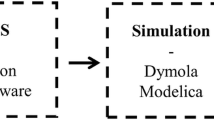Abstract
Carbon dioxide concentration in closed spaces is an indication of air quality and a means of measuring the number of occupants for controlling energy consumption. However, the dispersion of the gas and the accuracy of the concentration measurements as logged by carbon dioxide sensors are highly sensitive to the configuration of the closed space. Conducting case by case studies for each closed space is neither practical nor cost-effective. We hereby propose a formal model using cellular discrete-event system specifications for studying carbon dioxide dispersion indoors and for analyzing the effect of different configurations on the sensors measurements of the concentration. We present a case study of the model and compare the simulation results to ground truth data collected from two physical systems of two computer laboratories. The results demonstrate that the proposed model can be used to study carbon dioxide dispersion and the change of sensors’ readings in closed spaces based on the configurations of the space.
Access this chapter
Tax calculation will be finalised at checkout
Purchases are for personal use only
Similar content being viewed by others
References
Al horr, Y., Arif, M., Katafygiotoua, M., Mazroei, A., Kaushik, A., Elsarrag, E.: Impact of indoor environmental quality on occupant well-being and comfort: a review of the literature. Int. J. Sustain. Built Environ. 5(1), 1–11 (2016). https://doi.org/10.1016/j.ijsbe.2016.03.006
Jiang, A., Masooda, M.K., Soh, Y.C., Li, H.: Indoor occupancy estimation from carbon dioxide concentration. Energy Build. 131, 132–141 (2016). https://doi.org/10.1016/j.enbuild.2016.09.002
Labeodan, T., Zeiler, W., Boxem, G., Zhao, Y.: Occupancy measurement in commercial office buildings for demand-driven control applications—a survey and detection system evaluation. Energy Build. 93, 303–314 (2015). https://doi.org/10.1016/j.enbuild.2015.02.028
Khalil, H., Wainer, G., Dunnigan, Z.: Cell-DEVS models for CO2 sensors locations in closed spaces. In: Bae K.-H., et al. (eds.) 2020 Winter Simulation Conference (WSC), Virtual (2020, in press)
Arief-Ang, I.B., Hamilton, M., Salim, F.D.: RUP: large room utilization prediction with carbon dioxide sensor. Pervasive Mob. Comput. 46, 49–72 (2018). https://doi.org/10.1016/j.pmcj.2018.03.001
Wainer, G.: Discrete-event Modeling and Simulation: A Practitioner’s Approach, 1st edn. CRC Press, Boca Raton (2009)
Wainer, G., Giambiasi, N.: Cell-DEVS/GDEVS for complex continuous systems. Simulation 81(2), 137–151 (2005). https://doi.org/10.1177/0037549705052233
Khalil, H., Wainer, G.: Cell-DEVS for social phenomena modeling. IEEE Trans. Comput. Soc. Syst. 7(3), 725–740 (2020). https://doi.org/10.1109/TCSS.2020.2982885
López, A., Wainer, G.: Improved cell-DEVS model definition in CD++. In: Sloot, P.M.A., Chopard, B., Hoekstra, A.G. (eds.) ACRI 2004. LNCS, vol. 3305, pp. 803–812. Springer, Heidelberg (2004). https://doi.org/10.1007/978-3-540-30479-1_83
Batog, P., Badura, M.: Dynamic of changes in carbon dioxide concentration in bedrooms. Proc. Eng. 57, 175–182 (2013). https://doi.org/10.1016/j.proeng.2013.04.025
Pantazaras, A., Lee, S.E., Santamouris, M., Yang, J.: Predicting the CO2 levels in buildings using deterministic and identified models. Energy Build. 127, 774–785 (2016). https://doi.org/10.1016/j.enbuild.2016.06.029
Makmul, J.: Microscopic and macroscopic for pedestrian crowds. Dissertation, Mannheim University (2016)
Wainer, G.: CD++: a toolkit to develop DEVS models. Softw.: Pract. Exp. 32(13), 1261–1306 (2002). https://doi.org/10.1002/spe.482
St-Aubin, B., Wainer, G.: ARSLab DEVS web viewer. https://staubibr.github.io/arslab-prd/app-simple/index.html. Accessed 17 Sept 2020
ASHRAE Standard 62.1 Ventilation for Acceptable Indoor Air Quality (2013). http://www.myiaire.com/product-docs/ultraDRY/ASHRAE62.1.pdf. Accessed 15 Aug 2020
Zuraimi, M.S., Pantazaras, A., Chaturvedi, K.A., Yang, J.J., Tham, K.W., Lee, S.E.: Predicting occupancy counts using physical and statistical CO2-based modeling methodologies. Build. Environ. 123, 517–528 (2017). https://doi.org/10.1016/j.buildenv.2017.07.027
CO2 Spread Indoors. https://github.com/SimulationEverywhere-Models/Cell-DEVS-CO2_spread_indoor/blob/master/User%20Manual.txt. Accessed 18 Sept 2020
ARSLab CO2 Charting. https://github.com/SimulationEverywhere-Models/Cell-DEVS-CO2_spread_indoor/tree/master/scripts/Cell-DEVS_co2-charting. Accessed 20 Sept 2020
ARSLab YouTube. https://www.youtube.com/watch?v=vD7fB2A5hNY. Accessed 20 Sept 2020
Acknowledgments
The authors would like to thank Thomas Roller for developing the supporting tools that convert floorplans to 3-D scenarios and chart the simulation results [18].
Author information
Authors and Affiliations
Corresponding author
Editor information
Editors and Affiliations
Rights and permissions
Copyright information
© 2021 Springer Nature Switzerland AG
About this paper
Cite this paper
Khalil, H., Wainer, G. (2021). Modeling Carbon Dioxide Dispersion Indoors. In: Gwizdałła, T.M., Manzoni, L., Sirakoulis, G.C., Bandini, S., Podlaski, K. (eds) Cellular Automata. ACRI 2020. Lecture Notes in Computer Science(), vol 12599. Springer, Cham. https://doi.org/10.1007/978-3-030-69480-7_23
Download citation
DOI: https://doi.org/10.1007/978-3-030-69480-7_23
Published:
Publisher Name: Springer, Cham
Print ISBN: 978-3-030-69479-1
Online ISBN: 978-3-030-69480-7
eBook Packages: Computer ScienceComputer Science (R0)




